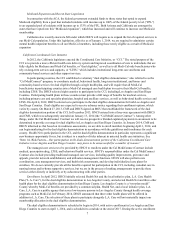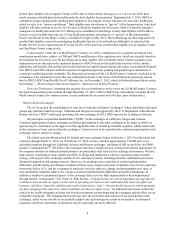Health Net 2013 Annual Report Download - page 19
Download and view the complete annual report
Please find page 19 of the 2013 Health Net annual report below. You can navigate through the pages in the report by either clicking on the pages listed below, or by using the keyword search tool below to find specific information within the annual report.17
that the strategy we have executed will be successful or that the investments we have made to incorporate
these provisions will be profitable.
Other provisions of the ACA include, among other things:
• providing funds to expand Medicaid eligibility to all individuals with incomes up to 133 percent of the
federal poverty level, commonly referred to as “Medicaid expansion” (as discussed below, this provision
was made optional for states under the Supreme Court's ruling on the ACA in June 2012);
• imposing an excise tax on high premium insurance policies;
• requiring premium rate reviews in certain lines of business;
• stipulating a minimum medical loss ratio (as adopted by the Secretary of HHS);
• limiting Medicare Advantage payment rates;
• increasing mandated “essential health benefits” in some lines of business;
• specifying certain actuarial value and cost-sharing requirements;
• eliminating medical underwriting for medical insurance coverage decisions, including “guaranteed
availability” with respect to individual and group coverage;
• limiting the ability of health plans to vary premiums based on assessments of underlying risk in the
individual and small group markets;
• increasing restrictions on rescinding coverage;
• prohibiting some annual and all lifetime limits on amounts paid on behalf of or to our members;
• limiting the tax-deductible amount of compensation paid to health insurance executives;
• requiring that most individuals obtain health care coverage or pay a penalty, commonly referred to as the
“individual mandate”;
• imposing a sales tax on medical device manufacturers; and
• increasing fees on pharmaceutical manufacturers.
The schedule for implementation of the provisions of the ACA generally varies from as early as enactment to as
late as 2018. A number of potentially significant provisions of the ACA became effective January 1, 2014, including the
health insurer fee, the operation of QHPs purchased through the exchanges, the risk adjustment, reinsurance, and risk
corridors programs described above, the guaranteed availability requirement, and the individual mandate. Other
provisions, such as the excise tax on certain high-premium insurance policies, and the employer mandate for certain
small- and mid-size employers, will not take effect until a later date. However, some of these provisions have had an
earlier impact on our operations, including in connection with the setting of our premium rates and general and
administrative expenses incurred in preparation for the ACA as discussed above.
Legal and Legislative Challenges to the ACA
Certain legal and legislative challenges to the ACA remain despite the U.S. Supreme Court’s June 2012 decision
in NFIB v. Sebelius. In Sebelius, the Supreme Court upheld the ACA’s individual mandate as valid under Congress'
taxing power. The Sebelius decision also permits states to opt out of the elements of the ACA that require expansion of
Medicaid coverage. Currently, Arizona and California have extended coverage to those now eligible under the Medicaid
expansion; however, the law in Arizona authorizing the expansion may be subject to litigation or referendum, which
may not be resolved until later in 2014 or beyond.
Notwithstanding Sebelius, other legal challenges to the ACA have been threatened or are still pending at lower
court levels, which could result in portions of the ACA being struck down. These threatened and pending challenges
include disputing the IRS’s official position that premium tax credits are available to low-income individuals who
purchase insurance through federally facilitated exchanges. In January 2014, a federal district court judge upheld the
IRS’s rule, finding that it was consistent with the text of the ACA. However, that ruling is being appealed, and similar
cases are also pending in district courts. A successful challenge in this area could significantly affect the affordability of
insurance to low-income individuals in states that do not administer their own exchanges, such as Arizona. A number of
cases challenging the rule that all health plans must provide contraceptive services have progressed through federal
appellate courts. The Supreme Court issued an order temporarily enjoining the government from fully enforcing the
























